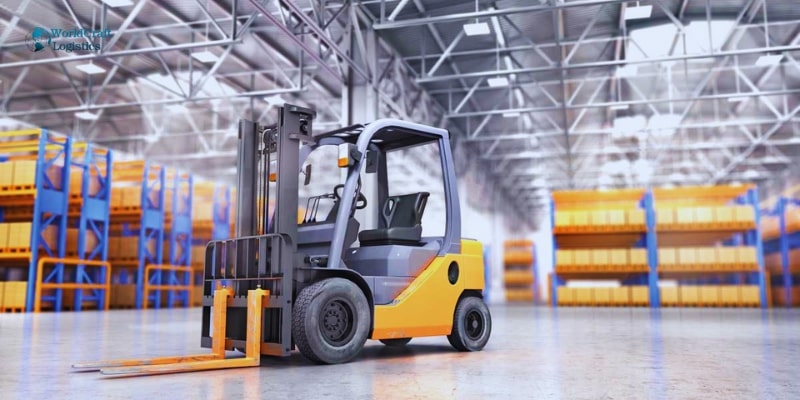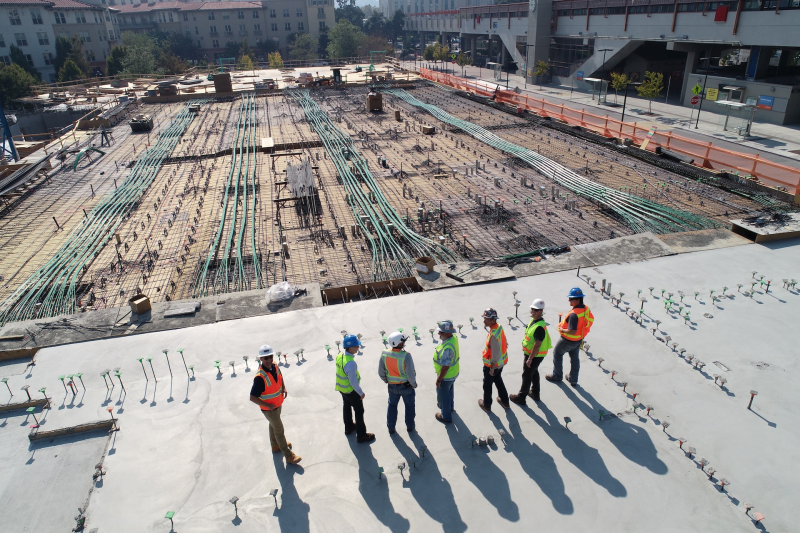In the dynamic environment of a warehouse, akin to a multifaceted engine, the synergy of human effort and efficient equipment is crucial for optimal performance. The complexity of warehouse operations necessitates the use of a diverse array of machinery and tools, each serving distinct functions across various processing areas. The judicious selection of the right equipment is not merely about enhancing productivity; it's a strategic move that can lead to significant savings in cost, time, and effort.
In this Worldcraft Logistics article, we delve into the common types of warehouse equipment and explore how each type can uniquely contribute to the enhancement of your warehouse operations. From forklifts and pallet jacks, which streamline the movement of goods, to sophisticated storage solutions and conveyor systems designed for efficiency, we will cover the essentials of warehouse equipment. This exploration aims to provide insights into making informed decisions about the equipment that best fits the specific needs and challenges of your warehouse, ultimately elevating its overall performance.
1. The Importance of Warehouse Equipment

The importance of warehouse equipment in the logistics and supply chain industry cannot be overstated. It plays a critical role in enhancing efficiency, safety, and productivity in a warehouse setting. Here’s a detailed look at why warehouse equipment is so vital:
- Enhanced Efficiency and Productivity: The right equipment streamlines various warehouse operations, from receiving and storing to picking and shipping. Automation and mechanization provided by equipment like forklifts, conveyor belts, and automated storage and retrieval systems (AS/RS) can significantly speed up these processes, allowing for quicker turnaround times and higher throughput.
- Improved Accuracy and Inventory Management: Advanced equipment, such as barcode scanners and RFID systems, aids in accurate tracking and management of inventory. This precision minimizes errors in order fulfillment, reduces the risk of lost or misplaced items, and ensures real-time inventory updates.
- Optimized Space Utilization: Storage and organization equipment like racking and shelving systems help in maximizing warehouse space. Efficiently designed storage solutions can increase the overall capacity of a warehouse, making it possible to store more goods in less space.
- Enhanced Worker Safety: Manual handling of goods, especially heavy or bulky items, poses significant risks of injury. Equipment like pallet jacks, forklifts, and safety harnesses reduce the physical strain on workers and lower the risk of accidents. This not only ensures compliance with safety regulations but also fosters a safer workplace.
- Cost Savings: While the initial investment in quality warehouse equipment may be substantial, the long-term savings are considerable. Improved efficiency leads to lower operational costs, while automated systems can reduce labor costs. Additionally, the right equipment can minimize damage to goods, thereby reducing wastage and costs associated with replacements or refunds.
- Adaptability and Scalability: As business needs change and grow, having the right equipment allows a warehouse to adapt and scale operations efficiently. This flexibility is crucial in responding to market demands, seasonal peaks, and business growth.
- Competitive Advantage: A well-equipped warehouse can offer faster and more reliable service, which is a significant competitive advantage in today’s fast-paced market. This can lead to increased customer satisfaction and loyalty, as well as a stronger market position.
In summary, investing in the right warehouse equipment is essential for modern warehousing operations. It not only optimizes operations and maximizes efficiency but also contributes significantly to the overall success and competitiveness of a business in the logistics sector.
2. Essential Types of Warehouse Equipment for Optimizing Operations
Optimizing warehouse operations requires a variety of essential equipment types, each designed to enhance efficiency, safety, and productivity. The following list includes some of the most important equipment types that are essential for optimizing warehouse operations, applicable to almost any warehouse regardless of its specific functions.
2.1 Dock Equipment
Selecting inappropriate dock equipment can compromise warehouse safety and endanger employees. The docking area, being a critical point for both receiving and shipping, must be prioritized for safety. To enhance the efficiency and safety of your dock area workflow, invest in high-quality loading equipment that facilitates the smooth transfer of goods to and from trucks. With evolving truck designs and escalating safety concerns, the right dock equipment not only makes processes more efficient and customizable but also safer and less labor-intensive.
| Name | Main functions | Illustrations | Average price |
Dock Boards and Plates | Portable platforms used to bridge the gap between the warehouse dock and the truck. They facilitate safe movement of materials between the dock and the truck. |  | |
Edge of Dock Levelers | Permanent fixtures at the dock edge that provide a smooth transition for moving goods from the dock to the truck. They compensate for height differences between the dock and the vehicle. |  | |
Truck Restraints | Safety devices that lock the truck in place during loading and unloading to prevent accidental movement. | | |
Dock Seals and Shelters | Structures that seal the space between the dock and the truck, providing weather protection and maintaining temperature control during loading and unloading. |  | |
Dock Bumpers | Protective devices mounted on the dock to absorb the impact of a truck backing into the dock, preventing damage to both the building and the vehicle. |  | |
Yard Ramps | Portable ramps used for loading and unloading goods from truck trailers to ground level, particularly useful in areas without a raised dock. | | |
Wheel Chocks | Safety devices placed in front of and behind truck tires to prevent the truck from rolling while it is parked at the dock. | | |
Dock Levelers & Dock Lifts | Mechanical or hydraulic systems used to adjust the height between the warehouse floor and the truck bed, ensuring a smooth transition for material handling equipment. |  | |
2.2 Conveyor Systems
Conveyor systems, essential for material handling, enable the movement of cargo from one point to another. Utilizing conveyors instead of manual labor accelerates or automates these processes, saving time and reducing labor. Conveyors also minimize the risk of injuries due to less human intervention, similar to the role of forklifts. They enhance picking, packing, and dispatching efficiency, and contribute to the automation of dimensioning, weighing, and sorting. While conveyors represent a significant investment, the numerous benefits they offer justify the cost, especially when optimally utilized.
| Name | Main functions | Illustrations | Average price |
Gravity Roller Conveyor | Uses rollers and gravity to move items; ideal for transporting lightweight packages and products. |  | |
Belt Conveyor | Features a continuous belt for transporting materials; versatile and commonly used for various types of cargo. |  | |
Plastic Belt Conveyors | Utilize a durable plastic belt; great for food industry and environments where cleanliness is a priority. |  | |
Flexible Conveyors | Can be expanded, bent, and configured to fit different spaces and routes; suitable for loading docks and packaging areas. |  | |
Vertical Conveyors | Move goods vertically between different levels; effective in facilities with limited floor space. | | |
Spiral Conveyors | Utilize a spiral design to transport items vertically; efficient for space-saving vertical movement. | | |
Pneumatic Conveyors | Use air pressure or vacuum to transport materials, typically powders or granules; ideal for chemical or food industries. | | |
Chain Conveyor | Consists of a series of chain links, suitable for heavy loads or harsh environments. | | |
Dust Proof Conveyors | Specifically designed to prevent dust accumulation, ideal for environments where cleanliness and contamination control are essential. | | |
Automotive Conveyors | Tailored for the automotive industry, these conveyors are built to handle automotive parts and assemblies. |  | |
2.3 Storage Equipment
Effective storage equipment is key to fully leveraging warehouse space for optimal fulfillment. It not only aids staff in quickly locating inventory but also safeguards valuable stock. Diverse storage solutions are available to meet the unique requirements of different warehouses.
| Name | Main functions | Illustrations | Average price |
Bins and Totes | These are containers used for storing, organizing, and transporting small items or parts. Bins and totes help in keeping inventory organized and can be easily moved or stacked. |  | |
Shelves | Shelving is a versatile storage solution for a variety of goods. They provide easy access to items and can be adjusted to accommodate different sizes of products. | | |
Racks | Racking systems are designed for storing palletized goods and larger items. They maximize vertical space and are essential for bulk storage in warehouses. | | |
Carousels | These are automated storage systems that rotate to bring items to the picker. Carousels are efficient for storing and retrieving small to medium-sized items, increasing picking speed and reducing the footprint needed for storage. |  | |
2.4 Mask Lifting Equipment
Lifting equipment encompasses various machines designed to streamline the transportation and storage of goods. Unstable lifting equipment poses risks such as wobbling during operation, potentially leading to damage and operational disruptions. When choosing lifting equipment, consider factors like inventory type and shelf height. While these machines can be costly, they offer significant functional benefits, including reduced manual labor, versatility across different areas, customizability, and ease of maintenance.
| Name | Main functions | Illustrations | Average price |
Forklifts | Powered vehicles used for lifting and transporting heavy loads on pallets. Forklifts come in different sizes and capacities, suitable for a variety of tasks. |  | |
Pallet Jacks | Manual or electric tools used for lifting and moving pallets. They are smaller than forklifts, making them suitable for tight spaces. |  | |
Hand Trucks | Also known as dollies, these are upright, two-wheeled carts used for moving smaller loads. They are ideal for transporting boxes and other compact items. |  | |
Service Carts | Rolling carts used for transporting tools, parts, and smaller items. They are commonly used in warehouses for order picking and stocking. | | |
Dollies and Castors | Small platforms on wheels used for moving heavy items. They can be placed under objects for easy rolling on flat surfaces. |  | |
Cranes, Hoists, and Monorails | Overhead lifting systems used for moving heavy or bulky items. They are essential in facilities that handle large, heavy materials. |  | |
2.5 Packaging Equipment
Packing is essential for protecting products and facilitating handling. Therefore, efficient packing equipment is crucial for assisting staff in quicker packing, thereby boosting productivity. Optimal packing equipment can lower labor costs and ensure consistency in the wrapping process. Additionally, it enhances inventory control by preventing product separation, streamlining inventory counts.
| Name | Main functions | Illustrations | Average price |
Industrial Scales | These are used for weighing goods and materials in an industrial environment. They come in various sizes and capacities, suitable for everything from small packages to large pallets. |  | |
Strapping and Banding Equipment | This equipment is used to secure bundles of goods or reinforce packages with straps or bands, ensuring stability and safety during transport. | | |
Stretch Wrap Machines | Machines designed to automatically or semi-automatically wrap pallets of goods with stretch film. This helps in securing the load for transportation and storage. | | |
Packing Tables | These are specialized workstations where products are packed and prepared for shipment. They often include features like storage for packing materials and tools to improve efficiency. |  | |
3. Worldcraft Logistics - A Place Equipped with Adequate Warehouse Equipment to Ensure the Safety of Your Shipments
Worldcraft Logistics equipped with a comprehensive array of warehouse equipment, meticulously designed to guarantee the safety and integrity of your shipments. At Worldcraft, we understand that the backbone of efficient logistics is not just about moving goods but ensuring they are transported under the safest conditions. Our facility is outfitted with state-of-the-art equipment, each piece chosen with the utmost care to cater to diverse logistics needs while prioritizing the security of your goods.
From advanced conveyor systems that streamline product movement to sophisticated packing equipment ensuring your items are securely wrapped and ready for transit, every aspect of our warehouse is optimized for excellence. Our storage solutions are versatile and robust, capable of accommodating a wide range of products, while our lifting equipment is top-notch, ensuring safe and efficient handling of goods, regardless of size or weight.
At Worldcraft Logistics, your peace of mind is our priority. We've invested in the best warehouse equipment to not only enhance operational efficiency but to also provide a safe haven for your products until they reach their final destination.
4. Answers to Common Questions About Warehouse Equipment
4.1 Is the Investment Cost for Warehouse Equipment High?
The investment cost for warehouse equipment can be substantial, varying based on the type, scale, and technology of the equipment. While basic tools are more affordable, advanced machinery like automated systems and forklifts are costly. Opting for used equipment can reduce expenses, but it may not offer the same efficiency as new, high-tech options. Despite the high initial outlay, investing in quality equipment can lead to long-term savings through improved efficiency, safety, and productivity.
4.2 How to Operate Various Types of Warehouse Equipment Efficiently?

To operate warehouse equipment efficiently:
- Train Operators: Ensure all staff are properly trained and certified in equipment use and safety.
- Regular Maintenance: Perform routine checks and maintenance to keep equipment in good condition.
- Understand Equipment Capabilities: Familiarize with the functions and limits of each equipment type.
- Prioritize Safety: Adhere to safety guidelines and protocols.
- Optimize Layout: Arrange the warehouse for smooth equipment operation and easy access to items.
- Leverage Technology: Use warehouse management systems for better coordination.
- Address Repairs Promptly: Handle minor repairs immediately to avoid major breakdowns.
- Energy Efficiency: Operate equipment in an energy-saving manner.
- Update Skills: Keep staff informed about new techniques and safety standards.
- Monitor Usage: Regularly review equipment usage for potential improvements.
4.3 Is Current Warehouse Equipment Integrated with New Technologies?
Yes, modern warehouse equipment is increasingly integrated with new technologies. This integration aims to enhance efficiency, accuracy, and speed in warehouse operations.





